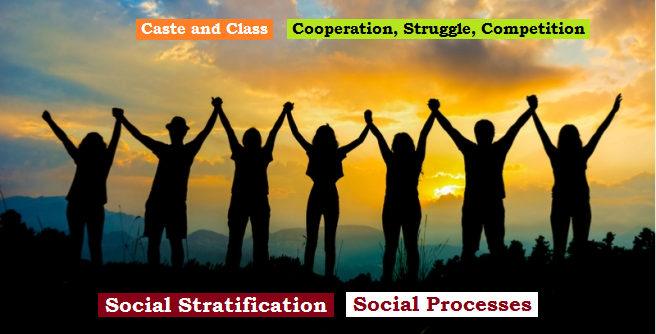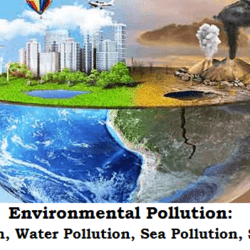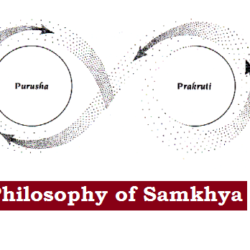
Social Stratification
Social Stratification refers to the existence of structured inequalities between groups in the society, based on socio-economic factors like wealth, income, race, education, gender, occupation, and social status, or derived power (social and political).
It is made up of human actions and relationship and their repetition over years to form institutions.
Caste and Class
Caste: Caste is that extreme form of social class organization in which the position of individuals in the status hierarchy is determined by descent and birth.
Class: A social class is a category of people who have a similar socio-economic status in relation to other segments of their community or society.
Caste Vs Class
| Caste | Class |
| 1. Class is acquired by birth or descent. (Ascribed Status) | 1. Class is not inherited, nut acquired through merit and ability. (Achieved Status) |
| 2. It is based on rigid principles and mobility is less. (Closed System) | 2. Class is changeable based on merit and choice. (Open System) |
| 3. Imposes many restrictions on the members like marriage. (Social Restriction) | 3. No restrictions on the members, even for customs like marriage. (Social Mobility) |
| 4. It is closely related with religion and Varna system. | 4. It is not affected by religion. (Secular) |
Characteristics of Social Stratification:
- It is universal: no society on this world which is free from stratification.
- It is a characteristic of society: not simply a function of individual differences. It unequally distributes social resources among categories of people.
- It persists over generations: It is closely linked to the family and to the inheritance of social resources from one generation to the next.
- It is supported by patterns of belief, or ideology: The caste system, for example, is justified in terms of the opposition of purity and pollution.
- It is Quantitative and qualitative: it not only involves qualitative inequalities but qualitative inequalities like in beliefs and attitudes about social status.
Merits of Social Stratification:
- Matches ability with higher position
- Encourages hard work for people at higher position and motivates for high positions
- Fulfills the needs of the society through creating different profession
- Introduces competition in the society
- Integrates people of different social classes as each recognises other
Demerits of Social Stratification:
- Creates social differences and hence social tension
- Introduces partiality and prejudice
- May promote exploitation of disadvantageous groups
Social Processes
Social processes refer to forms of social interaction that occur repeatedly, through which individuals and groups interact and establish social relationships.
There are several of forms of social interaction such as cooperation, conflict, competition and accommodation etc. They are universal features of all societies and focus on social sustainability.
Essential Elements of Social Process:
- Sequence of events
- Repetition of events
- Relationship between the events
- Continuity of events
- Social result
Perspectives of Social Processes:
- Conflict perspective: people are placed differently and unequally with conflict of interests, some are at advantageous and some are at disadvantageous positions.
- Functionalist perspective: human beings have to cooperate to meet their basic need and to reproduce themselves and the world.
Forms of Social Process:
Cooperation
- It is collective efforts (working together) for common interests.
- Division of labour in the society to fulfill certain needs implies cooperation.
- It evolved out of the feeling of bonded together, shared beliefs, sentiments (Mechanical Cooperation) and being depended on each other (Organic Cooperation).
- e.g. Specialized workers in a garment factory has to cooperate with each other. However, new technology has reduced their necessity for cooperation.
Competition
- It is striving against each other to get something limited.
- In contemporary world, it has become desirable and flourished with the onset of capitalism and modern technology.
- It is impersonal as competitors are not in contact and do not know one another. Therefore, competition is also defined as ‘an interaction without social contact’.
- Competition takes place on the unconscious level. Achievement of goal or the reward is regarded as the main object of competitors.
Conflict (Struggle)
- It implies clash of interests.
- Conflict is a competition in its occasional, personal and hostile forms. It is a process of seeking to obtain rewards by eliminating or weakening the competitors.
- Conflict is personal and its aim is to eliminate the opposite party.
- Conflict is a conscious activity, deliberate attempt to oppose or resist other competitors.
- It is not as continuous as competition and cooperation. It may take place all of a sudden and may come to an end after sometime.
Accommodation
- Despite conflict, there can be compromise and adjustment.
- Competing and conflicting individuals and groups adjust their relationships known as Accommodation.
- Conflicts are bound to be there in life. Since conflict cannot continue indefinitely, the conflicting individuals or groups reach an agreement and understanding and conflict comes to an end.
- Accommodation is a process by which those once in conflict can work together in common enterprises.
- Accommodation is mainly an unconscious activity because a newborn individual accommodates himself with his environment. Sometimes, individuals and groups make deliberate attempt to stop fighting and start working together.
- It is a continuous process, throughout the life; one has to accommodate oneself with various situations.


 Home
Home Syllabus
Syllabus Contact Us
Contact Us




